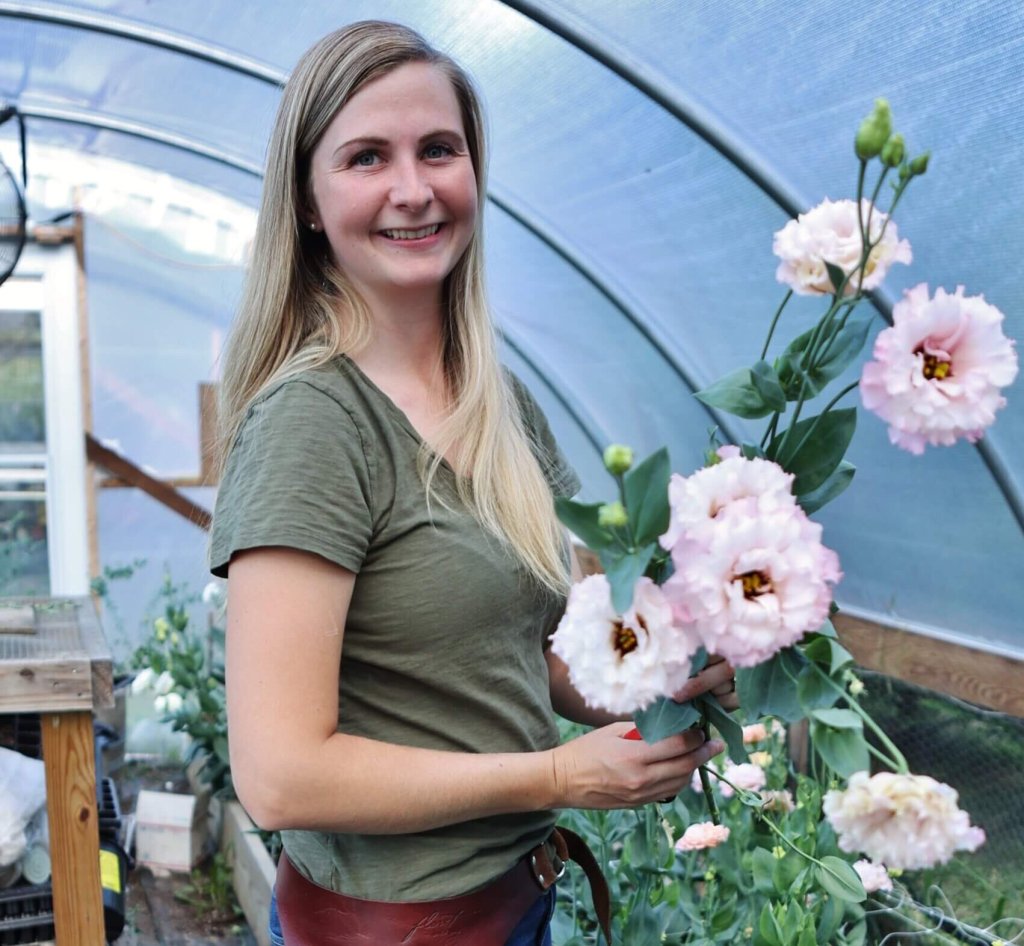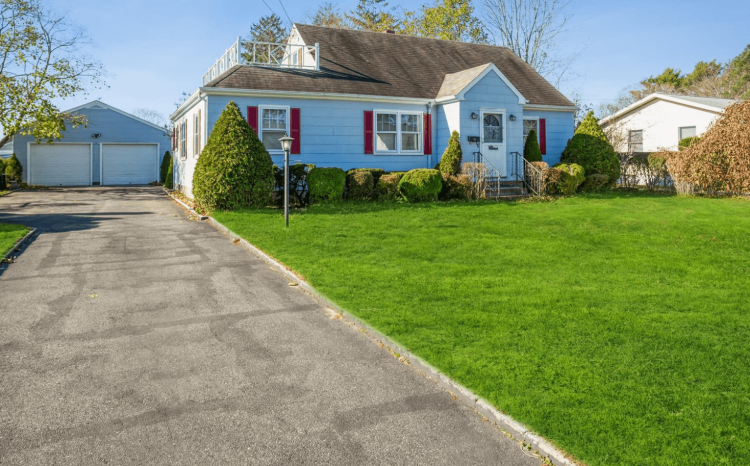Flowers brighten up a room, bring a smile to people’s faces, are used to offer condolences and are the centerpiece for practically any occasion. Many flowers sold in stores are mass-produced in factory-like settings, but not on the East End.
On a farm by the water in Riverhead, Kim Endres offers a refreshing change. A flower farmer and florist, she has found a niche growing specialty cut flowers, designing their arrangement with a wildflower flair and putting the freshest flowers in homes from the Hamptons to the North Fork.
Her eye for the precision it takes to grow these backyard blooms began when she cut flowers her mother grew during what was a dark time for everyone.
“I worked in healthcare back throughout the entire pandemic — and obviously, you know how terrible that was,” Endres says. “I worked in primary care and we actually started to work a couple of days from home and it was miserable.”
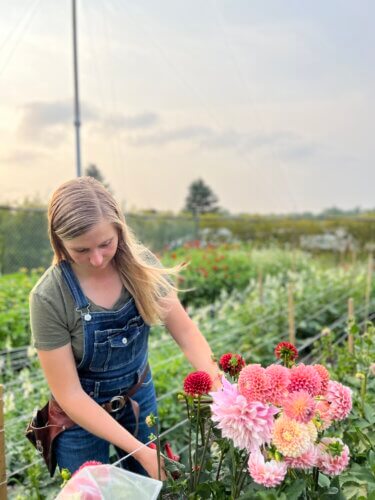
Throughout her childhood, her mother had perennial gardens so she grew up cutting flowers.
“During the pandemic, the flowers were the only thing that would make me happy at the end of the day, being in the office, being in a mask, being in a shield, dealing with patients,” she recalls of the time she worked at the front desk of a doctor’s office.
She began simply by making bouquets as a way to cheer others up, putting them in a bucket of water by a roadside stand on Flanders Road and trying to sell them.
The weekend before Mother’s Day 2020, Endres cut “whatever my mom had blooming and they were all sold out within an hour.” She quickly realized she might be onto something special.
Soon she began planting annuals in her backyard, which is more like a family compound, but that is how the name Backyard Blooms sprouted. She began on a small scale and every time she put out a bouquet, it would sell. Now, she grows in fields of flowers and in two greenhouses on slightly less than an acre.
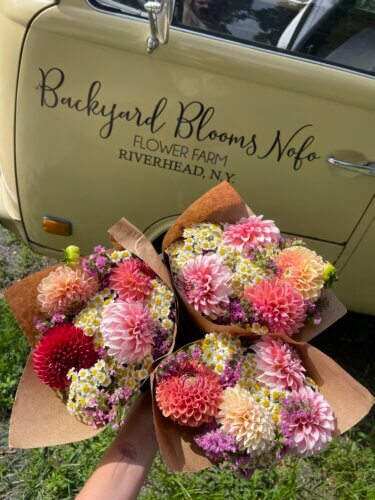
Endres had some experience working the land. Her family used to have a farm in Calverton, which was sold three years before she got into flower farming. “My biggest goal is to hopefully one day buy the family farm back,” she says. “I worked there growing up, so I was always constantly around farming. Even though they didn’t do flowers, they just did vegetables,” she says. On her website, she has a photo of her sitting on the farmstand next to her mother, which appeared in The Riverhead News-Review when she was little.
Even with some background in farming, there was “a really big learning curve” when it came to growing flowers. But, she says, “I saw the window of opportunity and I had to take it.”
In May of 2022 with Backyard Blooms quite literally blooming, she decided to leave her job in healthcare to pursue flower farming full-time.
“It was just the demand was so high and it was just like you had to take the leap. The leap is the hardest part because what if this doesn’t work? What am I gonna do?”

So far it has worked with clients being drawn to the specialty flowers.
In the spring she grows a huge peony crop. While she has one peony field, she is already planning a second for next year. The hoop houses are full with ranunculus, anemones and sweet peas (Lathyrus odoratus).
“Icelandic poppies are also nice in the spring. We do the daffodils, which is the narcissus. Then once the spring fizzles down, we go into lisianthus, specialty sunflowers, dahlias. We do annuals still like the wildflower look, zinnias, feverfews, snapdragons, scabiosa gladiolus — that kind of stuff,” she explains.
Coming up this fall, the dahlias take off. “They like that little bit of crisp air, so they go crazy during the fall. We have huge dahlias up until about the first frost, which is around Halloween,” she says.
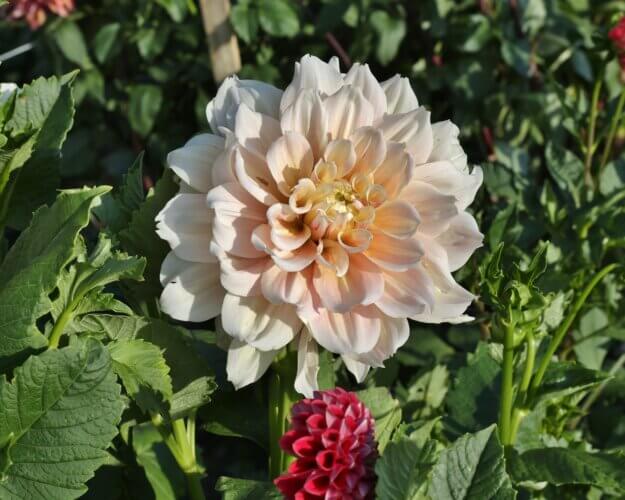
She also grows long-stem mums — not flower pot mums. Then during the winter, she usually makes specialty, evergreen wreaths.
Seeding for the spring season starts in October. Last season, she grew 20,000 tulips, using tulip bulbs shipped in from California, which come direct from Holland. They arrived in 67 crates. “It was insane. I don’t know what was wrong with me, but I planted them all by hand last October.”
She learned about each flower as she went. “A lot of the stuff that, like the peonies, I knew about, my mom always had dahlia gardens,” but she credits much of her latest education to an online growing course she took with Erin Benzakein, who is considered to be one of the country’s most influential farmer-florists.
Benzakein is a New York Times bestselling author of three books and the executive producer of the Emmy-nominated documentary television series, Growing Floret on the Mangloia Network.
“She started from nothing, had kids, the whole nine. “So she was just such an inspiration,” Endres says.
While she still offers flowers on the side of the road, she has gained a wide customer base. She now creates floral arrangements for weddings and other special occasions. She started selling at the Riverhead farmers market, and, this season, she has been setting up shop at the East Hampton and Montauk farmers markets.
The quality is what stands out.
“You get your regulars off the market — they come every week. They know what you have and they know the difference between cut flowers that are American-grown cut flowers versus the imported flowers,” she explains. “Once people realize the difference between fresh cut flowers versus imported flowers, that’s when you have them hooked.”

Endres explains that 80% of the flowers sold in America are imported. “I know that sounds like a crazy number, but 80% are from the Dutch, like tulips,” she says. “The main difference between fresh cut flowers here that I grow and the ones that are imported is the flowers that are imported are usually cut and are in transport at least two weeks before they come to your table.”
“So whether that be just say, roses — they cut them, they hydrate them, they package them, put them in all sorts of plastic that they don’t need to be in. Then from there, they go onto a plane to a shipping distribution center, to an auction. Whoever buys them, the wholesalers here, they bid on them, they get them shipped in. By the time they get them, they have to rehydrate them. So it’s almost about a two-week process before they even can be on your table.”
By comparison, Endres harvests her flowers either the night before or the day she is going to the markets or putting them out on the stand. Instead of store-bought flowers lasting three to five days once purchased, Backyard Bloom customers can enjoy theirs for at least a week to 10 days with proper care.
“I’ve even had people at the farmers market say that they lasted almost two weeks,” she adds. Endres touts that she does not spray pesticides. “We can’t be certified organic because it takes about 20 years to become certified organic, but a lot of the roses and stuff you buy from the store are sprayed with hundreds of pesticides and chemicals,” she says, mentioning videos of roses being sprayed by people in hazmat suits.
“A lot of people don’t realize. . . flowers are a luxury item. They don’t care, per se how they’re made. They want them, end of story. They don’t care about the impacts that it has on the people spraying them, the communities around the massive growing commercial facilities. They don’t care about the birth defects it causes in those areas. It’s just — everybody always wants roses, Valentine’s Day roses.”
“That’s why I’m trying to bring back the sustainability part of it. If I can’t grow it, I have local farmer friends that grow it — we all support each other.”
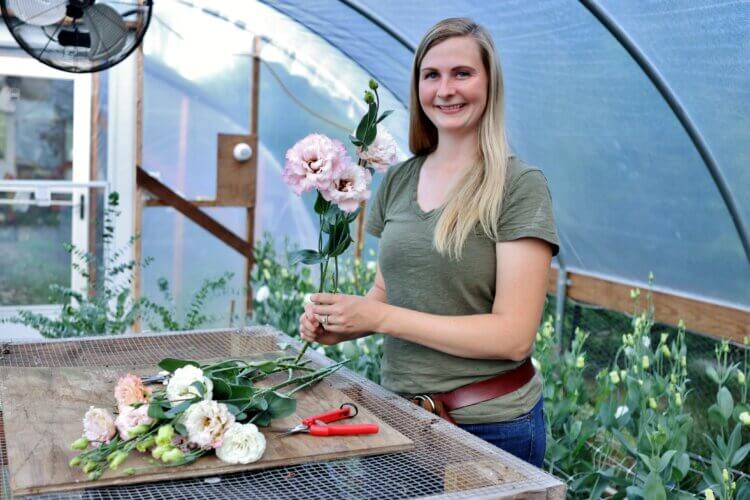
She sources from Johnny’s Seeds, an employee-owned seed producer and merchant in Winslow, Maine. “I like supporting things like that or even small seed companies. Erin Benzakein just started her huge seed company, so I love getting stuff from her. I feel like they’re a better quality than the ones you can get at Home Depot — just because you’re paying 99 cents for a thing of seeds that makes me nervous. Why is it so cheap?”
When it comes to her bouquets, she sticks to a natural style suitable for wildflowers. “I feel like I’ve always learned what grows together goes together,” she says.
Bouquets are wrapped in brown craft paper, stamped with her logo on the sleeve and wrapped in twine.
“I don’t feel like there’s any reason to ever wrap flowers in plastic because it just gets taken off, it gets thrown out and it never leaves — it never biodegrades. I think it’s a waste of plastic. I think it’s horrible for the environment. It’s almost as bad as balloons at this point.”
The craft paper is biodegradable. The twine will break down better than rubber bands. Even small impacts can make a difference for the environment, she says.
“Even with wedding work, we try to stay away from all the foam” that is often used to arrange flowers in a certain way within the vase. “We use chicken wire just to try to stop the craziness that happens within the floral industry. The amount of microplastics and plastic in general that gets used is just filling up the landfills.”
Endres sees herself as part farmer, part craftsperson. She says growing specialty cut flowers takes precision and a creative eye. Thought goes into when to cut the flowers. For the peonies and the ranunculus, for instance, you never want to cut them when they’re fully open because their vase life will be shortened.

“For the peonies, we cut them in like a marshmallow stage, which means the bud is squishy like a marshmallow. So when a lot of people buy them at the markets or at the stand, they look so small because they’re so tight,” she explains. “And then you have to realize that what they open up to, they open up to as big as a softball. But they last 10 to 14 days that way compared to if you cut them when they were open, they’d last four or five days.
“Dahlias are the same way. We usually cut them when they’re about 50 to 75% open because they will open in a vase with flower food,” she says, adding she will also only cut them at night because they are stressed during the summer days.
There is also an art to cutting the flowers. “Sometimes with peonies and the ranunculus, I use a floral knife in the field,” as opposed to a clipper, “just because the floral knife creates a sharper cut for those types of flowers and it helps with the vase life and the knife’s usually cleaner and less bacteria.” With a blossoming small business, Endres is glad she gave flower farming a chance.
“You don’t really know until you try. And if you fall on your face, then you just learn to be better the next time. We’ve had crop failures and it sucks and you have to move on from it, but that’s the best part of it. You get to just keep going,” she says. “And that’s what I love about it.”
This article appeared in the August 18, 2023 issue of Behind The Hedges. Read the full digital edition here. Be sure to check out more Master Craftsman articles.

